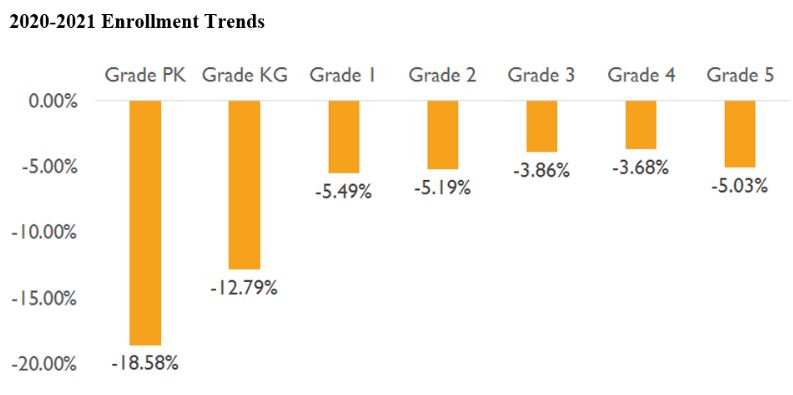
by James A. Bacon
There are many gaps and omissions in the Northam administration’s just-published “2021 Annual Report on the Conditions and Needs of Public Schools in Virginia” — most notably the lack of recognition that the acute problems described by the report stem in part from policies endorsed by the Northam administration itself — but the Board of Education (BOE) document does highlight several issues that any fair-minded person would acknowledge need highlighting.
One of those issues is the sharp decline in public school enrollment since the onset of the COVID-19 pandemic, most notably in Pre-K and Kindergarten. As seen in the graph above, pre-K enrollment is down 18.6% and Kindergarten is down 12.8%.
Do these declines portend comparable declines in public school enrollment as these age cohorts work their way through the educational pipeline? Has something fundamental changed about the way parents of young children think about their schooling? Or are these declines transitory blips that will disappear as America learns to live with the virus?
These questions are vitally important. If public school enrollment in Virginia falls by 10% or more over the long term, the fiscal impact could be momentous.
As consequential as the issue is for public schools, the report devotes virtually no analysis to it. The report never proffers an explanation for the fall-off. Rather, it settles for placing the enrollment decline in the context of the COVID-19 epidemic. In the section discussing enrollment impacts, the Board says, “The Board anticipates that many of the challenges and uncertainties experienced by local school divisions will continue long after the pandemic ends.” Leaders are left to assume that COVID is somehow to blame.
Surely, there is more to say about the enrollment decline than that. Why would parents be yanking their youngest children out of the public school system, and not middle- or high-school kids?
One factor impacting the thinking of parents with young children might be the paucity of child care. During the pandemic, child care has become notoriously difficult to find. For women who have to juggle work responsibilities with child care, the challenge is especially acute.
Given that child care has become a major preoccupation, though, it would stand to reason that parents would be more likely, not less, to enroll their children in Kindergarten and pre-K programs. After all, K and pre-K provide a child-care function. One would expect that poor working mothers would be particularly eager to avail themselves of this option. Yet precisely the opposite has occurred.
As the BOE report says:
Head Start enrollment was down 30% for the 2020-2021 school year. Enrollment numbers were down six percent for the Virginia Preschool Initiative, despite extending the enrollment period to January 2021. Overall preschool enrollment decreased by 18.58%. Participation in child care subsidy dropped to a low of ~14,500 children in January 2021, a drop of 43% from before the pandemic.
Children who participate in Head Start or subsidized child-care programs come mainly from single-parent households, many of which are headed by poor, working mothers who need child care but lack the financial means to pay for it. Why aren’t they, of all people, enrolling their children in greater numbers? Are they deterred by a fear of COVID? Do they share the broader disenchantment with public schools? Is there a reason we haven’t identified?
Something isn’t adding up. Something is happening at a sociological level that educators and the chattering classes have yet to put their finger on. I have no idea what that is. But I would expect the Board of Education to be doing its damnedest to find out. From what I can tell from the BOE report on conditions and needs, not only does the BOE not have any answers, it’s not even asking the question.

Leave a Reply
You must be logged in to post a comment.